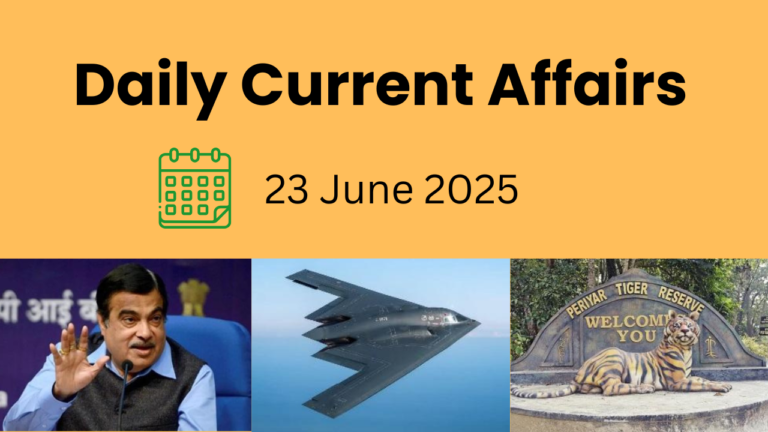1. Iran Declines to Resume Nuclear Deal Negotiations with the U.S.
Context: Iran has refused to re-enter negotiations with the United States regarding its nuclear program. This decision follows years of tension, especially after the U.S. withdrawal from the Joint Comprehensive Plan of Action (JCPOA) in 2018.
Reasons Behind Iran’s Decision:
- The Trump administration imposed harsh sanctions on Iran, particularly targeting its oil industry, as part of a “maximum pressure” strategy.
- Former President Trump demanded negotiations, warning of possible military action if Iran refused.
- Iran’s Foreign Minister declared that Iran would only negotiate with the remaining JCPOA members (Europe, Russia, and China) but not with the U.S.
Understanding the JCPOA (2015):
Participants:
- Iran
- P5+1: The five permanent members of the UN Security Council (China, France, Russia, the UK, and the U.S.) plus Germany
- European Union (Participated in negotiations)
Iran’s Commitments Under the JCPOA:
- Nuclear Restrictions: Iran agreed not to produce highly enriched uranium or plutonium for nuclear weapons. Its nuclear facilities (Fordow, Natanz, Arak) were restricted to civilian purposes.
- Centrifuge Limits: Iran limited its centrifuges and reduced its enriched uranium stockpile.
- 5% enrichment: For nuclear power.
- 20% enrichment: For research or medical use.
- 90% enrichment: For nuclear weapons (not allowed under JCPOA).
- Monitoring & Verification: Iran allowed unrestricted access to International Atomic Energy Agency (IAEA) inspectors, ensuring compliance.
- Joint Commission Oversight: A commission was set up to monitor implementation and resolve disputes.
Commitments from Other Signatories:
- Sanctions Relief: The EU, UN, and U.S. lifted nuclear-related sanctions but kept restrictions on Iran’s ballistic missile program, support for terrorism, and human rights abuses.
- Oil & Financial Transactions: The U.S. partially lifted sanctions on Iran’s oil exports but kept financial restrictions.
- UN Arms & Missile Ban: Lifted after five years, provided IAEA confirmed Iran’s compliance.
- Violation & Sanctions “Snapback”: If Iran violated the deal, the UN Security Council could vote to reinstate sanctions.
Breakdown of the Deal & Rising Tensions:
- Trump’s Withdrawal (2018): The U.S. exited the deal, prompting Iran to resume nuclear activities.
- Iran’s Escalation (2023): Iran enriched uranium to near weapons-grade levels, alarming the international community.
- Expiration of Key Provisions (2023-2024): Several JCPOA restrictions began to expire, raising concerns over Iran’s nuclear ambitions.
Goals of the JCPOA:
- Delay Nuclear Weapon Development: The agreement aimed to extend Iran’s “breakout time” (the time needed to build a nuclear weapon) from a few months to at least a year.
- Prevent Regional Conflict: The deal sought to avoid a military response from Israel or a nuclear arms race in the Middle East.
Challenges to Renegotiation:
- Deep Mistrust: Decades of hostility and past diplomatic failures have made trust-building difficult.
- Conflicting Goals: The U.S. seeks a broader, stricter agreement, while Iran wants a return to the original JCPOA.
- Domestic Political Pressure: Hardliners in both Iran and the U.S. oppose compromise, making diplomatic progress difficult.
Conclusion:
Iran’s refusal to negotiate with the U.S. underscores worsening diplomatic relations and a growing nuclear threat. With key JCPOA provisions expiring, the risk of a regional crisis looms larger than ever.
2. Seagrass Conservation: A Key to Global Biodiversity
Context: A recent study in Nature Reviews Earth & Environment warns that seagrass ecosystems are declining at an alarming rate of 1-2% per year due to human activities. These vital marine habitats play a crucial role in climate action, biodiversity conservation, and coastal protection, yet they remain highly vulnerable.
What Are Seagrasses?
Seagrasses are underwater flowering plants that form dense marine meadows. They evolved from terrestrial plants, adapting to life in saltwater. Unlike seaweed (which is algae), seagrasses have roots, stems, leaves, and can produce flowers and seeds.
Why Seagrass Ecosystems Matter
1. Climate Action & Carbon Sequestration:
Seagrasses act as the “lungs of the sea”, absorbing carbon up to 35 times faster than tropical rainforests, making them essential in combating climate change.
2. Marine Biodiversity & Wildlife Protection:
- Provide nursery habitats for commercial fish species.
- Offer shelter to endangered marine species, including sea turtles and seahorses.
3. Coastal Protection:
- Act as natural barriers, reducing coastal erosion and storm impact.
- Help stabilize shorelines, protecting coastal communities.
4. Economic Significance:
Seagrass meadows contribute $6.4 trillion annually to the global economy by:
- Supporting fisheries and sustainable tourism.
- Enhancing livelihoods of coastal communities.
Seagrass Ecosystems in India:
With a coastline of 11,098 km (2023-24), India has extensive seagrass meadows in:
- Gulf of Mannar
- Palk Bay
- Andaman & Nicobar Islands
- Lakshadweep Islands
- Gulf of Kutch
Threats to Seagrass Ecosystems:
- Human Activities: Urbanization, pollution, and agricultural runoff degrade seagrass beds.
- Weak Law Enforcement: Lack of strict regulations hampers conservation efforts.
- Biodiversity Loss: Unregulated fishing, boating, and dredging destroy seagrass meadows.
Global and Indian Conservation Efforts:
Global Success Stories:
- Seagrass Watch: A citizen science program that trains volunteers and NGOs to monitor and conserve seagrass habitats.
- Blue Carbon Initiative: Focuses on carbon sequestration in coastal ecosystems, including seagrasses, mangroves, and salt marshes.
Indian Conservation Initiatives:
- National Policy on Marine Fisheries (2017): Recognizes seagrass meadows as essential ecosystems, along with mangroves and coral reefs.
- Climate Resilience Project: Implemented in Andhra Pradesh, Maharashtra, and Odisha, with funding from the Global Climate Fund (GCF).
- Seagrass Restoration in Gulf of Mannar & Palk Bay: Focuses on ecosystem recovery and protection.
Conclusion:
Seagrass conservation is vital for biodiversity, climate stability, and economic sustainability. Strengthening protection policies, restoration projects, and global collaboration is essential to reverse seagrass decline and safeguard marine ecosystems for future generations.
3. U.S. Withdrawal from the Loss and Damage Fund: A Setback for Climate Justice
Context: The United States has withdrawn from the board of the Loss and Damage Fund (LDF), a move that raises concerns over global climate finance and accountability.
Trump Administration’s Climate Disengagement:
This decision aligns with the Trump administration’s pattern of withdrawing from international climate agreements, including:
- Exiting the Paris Agreement
- Halting U.S. scientists’ participation in the Intergovernmental Panel on Climate Change (IPCC)
- Cancelling contributions to the Green Climate Fund
What is the Loss and Damage Fund (LDF)?
- Established at COP27 (2022) under the UNFCCC framework.
- Provides financial support to regions facing climate-induced economic and non-economic losses.
- Covers disasters such as extreme weather events (hurricanes, floods) and slow-onset changes (rising sea levels, desertification).
- Governed by a Board that allocates funds, with the World Bank serving as an interim trustee.
Objectives of the LDF:
- Aid vulnerable developing nations in coping with climate-related disasters.
- Bridge the financial gap between climate adaptation, mitigation, and recovery efforts.
Concerns Over the LDF’s Effectiveness:
- Slow Fund Disbursement: Climate funds often fail to reach affected communities immediately, particularly at the sub-national level.
- Growing Climate Crisis: Without aggressive emission reductions, more countries will suffer irreversible climate impacts, increasing the need for mitigation, adaptation, and financial aid.
- U.S. Withdrawal Undermines Climate Justice: As one of the world’s largest historical polluters, the U.S. must be held accountable for its role in climate-induced damage.
India’s Climate Finance Approach:
- India faced $56 billion in weather-related damages (2019-2023) but has focused more on mitigation than adaptation.
- India’s Union Budget 2024 introduced a climate finance taxonomy, raising hopes for better access to global climate funds.
- However, lack of clear guidelines on accessing LDF funds may leave vulnerable communities exposed.
Conclusion & The Way Forward:
- The Loss and Damage Fund must address inefficiencies in existing climate finance institutions like the Green Climate Fund.
- Tackling the root cause of climate change—carbon emissions—is crucial for long-term solutions.
- India needs a comprehensive legal and policy framework to streamline climate finance for adaptation and loss & damage, ensuring locally led adaptation strategies benefit the most affected communities.
4. Boosting Value Addition in Spices: Path to Achieving $10 Billion Export Target by 2030
Context: Despite being the largest producer and exporter of spices, India holds only a 0.7% share in the global seasoning market, which is valued at $14 billion in 2024. The World Spice Organisation (WSO) has stressed the need for enhanced value addition in the spice industry to help the Spices Board of India achieve its ambitious $10 billion export target by 2030.
India’s Spice Export Landscape:
- India exports 1.5 million tonnes of spices annually, valued at $4.5 billion, covering 25% of the global spice market (worth $20 billion).
- Global Competition:
- China holds 12% of the global seasoning market.
- The U.S. holds 11% of the global seasoning market.
- Current Value Addition:
- Only 48% of Indian spice exports consist of value-added products, while the rest are exported as raw whole spices.
- To reach the $10 billion export target, the value-added share must rise to 70%.
- New Market Opportunities:
- Nutraceutical and pharmaceutical applications for spices can unlock diverse, high-value export avenues beyond culinary use.
Growing Global Competition:
- Vietnam, Indonesia, Brazil, and China are emerging as major players in the global spice trade.
- African nations have also entered the spice production sector, intensifying market competition.
- Domestically, new spice-producing regions are emerging in North-Eastern India, Odisha, and Jharkhand, boosting overall production capacity.
Spices Board of India:
Overview:
- Established: 1987 under the Spices Board Act, 1986.
- Ministry: Operates under the Ministry of Commerce and Industry, Government of India.
- Headquarters: Kochi, Kerala.
Key Responsibilities:
- Promotion of spice exports.
- Quality control & certification of Indian spices.
- Research & development in spice cultivation.
- Farmer training and capacity building.
- Implementation of schemes supporting farmers and exporters.
Notable Initiatives:
- Spice Parks: Provide processing & value-addition infrastructure.
- e-Spice Bazaar: A digital marketplace connecting farmers and buyers.
- State-of-the-art Testing Laboratories: Located in Mumbai, Chennai, Delhi, Tuticorin, Kandla, and Guntur for quality assurance in spice exports.
World Spice Organisation (WSO):
- Established: 2011.
- Affiliation: Technical partner of the All-India Spices Exporters Forum (AISEF).
- Focus Areas: Sustainability, food safety, and value addition in spices.
Key Objectives:
- Promoting sustainable spice farming.
- Ensuring food safety & quality standards.
- Educating farmers on pesticide management & organic cultivation.
- Collaborating with international regulatory bodies to standardize spice trade regulations.
Way Forward: Strengthening India’s Spice Sector:
- Increasing Value Addition: Expanding spice processing, packaging, and branding to enhance global competitiveness.
- Investment in R&D: Developing spice-based nutraceuticals, pharmaceuticals, and cosmetics to diversify exports.
- Strengthening Supply Chain Infrastructure: Expanding Spice Parks and boosting digital platforms like e-Spice Bazaar.
- Farmer Empowerment: Providing training and incentives for organic and sustainable farming practices.
- Global Market Expansion: Strengthening trade ties with new export destinations and aligning with international quality standards.
By enhancing value addition and innovation, India can solidify its leadership in the global spice trade and achieve the ambitious $10 billion export target by 2030.
5. Empower Women by Strictly Enforcing the Law – Supreme Court
Context: The Supreme Court of India has reiterated that women do not need sympathy but empowerment, emphasizing the strict implementation of laws to ensure justice. The observation was made by Justice Bela Trivedi on the eve of International Women’s Day.
Justice Trivedi is one of only two women judges currently serving in the Supreme Court, alongside Justice B.V. Nagarathna.
Courtroom Exchange on Women’s Empowerment:
Statement on “Ladies at Home”:
- A senior advocate remarked that “ladies at home” need empowerment.
- Justice Trivedi clarified that empowerment is necessary for all women, not just homemakers.
Case Details: Sexual Harassment & Strangulation Attempt:
- The case, from Tamil Nadu, involved allegations of sexual harassment and molestation.
- The accused had been in custody for seven months.
- The defense argued that the case involved only a “simple injury”, not an attempt to murder.
Court’s Stand on the Injury:
- Justice Trivedi rejected the claim of a “simple injury.”
- The injury was due to strangulation with a nylon rope, highlighting the seriousness of the crime.
Final Decision:
- The Supreme Court issued a notice to the State government, considering a re-evaluation of the sentence.
- However, it strongly emphasized the need for strict enforcement of laws to protect women.
Legal and Constitutional Provisions for Women’s Empowerment:
Constitutional Provisions:
- Article 14 – Guarantees equality before the law.
- Article 15(3) – Allows the State to make special provisions for women and children.
- Article 16 – Ensures equal opportunities in public employment.
- Article 39(a) – Promotes equal livelihood opportunities for men and women.
- Article 42 – Directs the State to ensure just and humane working conditions and maternity relief.
- Articles 243D & 243T – Reserves one-third of seats for women in Panchayati Raj institutions and urban local bodies.
Key Legal Provisions for Women’s Rights:
- The Protection of Women from Domestic Violence Act, 2005 – Shields women from domestic abuse.
- The Dowry Prohibition Act, 1961 – Bans the practice of dowry.
- The Sexual Harassment of Women at Workplace Act, 2013 – Protects women from harassment at workplaces.
- The Maternity Benefit Act, 1961 (Amended in 2017) – Provides maternity leave and financial support.
- The Prohibition of Child Marriage Act, 2006 – Prevents child marriages.
- The Hindu Succession (Amendment) Act, 2005 – Grants equal property rights to daughters.
Government Schemes for Women’s Empowerment:
Social Welfare & Protection:
- Beti Bachao Beti Padhao (BBBP) – Promotes girl child education and prevents female foeticide.
- One Stop Centre Scheme – Provides legal, medical, and psychological support to women affected by violence.
- Mahila Shakti Kendra – Offers skill development and employment opportunities.
- Women’s Helpline (181) – Provides immediate assistance to women in distress.
Economic & Financial Support:
- Pradhan Mantri Matru Vandana Yojana (PMMVY) – Grants financial assistance to pregnant and lactating women.
- Sukanya Samriddhi Yojana – Encourages savings for a girl child’s education and marriage.
- NITI Aayog’s Women Entrepreneurship Platform (WEP) – Supports women entrepreneurs.
Healthcare & Safety:
- Ujjwala Scheme – Provides free LPG connections to reduce health hazards from traditional cooking fuels.
Institutional Mechanisms for Women’s Welfare:
- National Commission for Women (NCW) – Handles grievances and advocates for women’s rights.
- Ministry of Women and Child Development (MWCD) – Implements policies for women’s welfare and protection.
Way Forward: Ensuring Real Empowerment for Women
- Strict Law Enforcement: Implementing existing laws effectively to ensure swift justice for crimes against women.
- Judicial Sensitization: Courts must prioritize gender-sensitive interpretations of legal provisions.
- Economic Independence: Enhancing women’s participation in entrepreneurship, workforce, and leadership roles.
- Strengthening Legal Frameworks: Introducing stricter penalties for crimes like sexual harassment, domestic violence, and dowry-related offenses.
- Raising Awareness: Promoting legal literacy and awareness among women about their rights and available protections.
Women’s empowerment goes beyond policy discussions—it requires real action, legal enforcement, and societal change. The Supreme Court’s stance reinforces the urgent need for strict legal implementation to ensure true gender equality in India.
6. Tahawwur Hussain Rana Extradition Case
Context: The United States Supreme Court has rejected Tahawwur Hussain Rana’s plea against his extradition to India. Rana had filed an “Emergency Application for Stay” after former US President Donald Trump approved his extradition. With this ruling, India is now set to bring him to trial for his alleged role in the 2008 Mumbai terror attacks.
Background: Rana’s Involvement in 26/11 & Other Terror Cases
- Rana, a Pakistani-origin Canadian national, is accused of providing logistical support for the 2008 Mumbai terror attacks, which killed 166 people.
- He allegedly helped his associate David Coleman Headley in conducting reconnaissance for the attack.
- 2009 Arrest (Chicago):
- Arrested for involvement in the Mumbai attacks and a foiled attack on the Danish newspaper Jyllands-Posten.
- Convicted in 2013 for supporting Lashkar-e-Taiba (LeT) and sentenced to 168 months (14 years) in prison.
- Released on compassionate grounds in 2020, but immediately faced an extradition request from India.
Legal Battle Over Extradition:
- December 2019: India formally requested Rana’s extradition under the India-US Extradition Treaty (1997).
- Rana’s Defense Argument:
- Claimed “double jeopardy”, arguing that he had already been acquitted of charges related to India.
- US Magistrate’s Ruling (May 2023):
- Rejected his plea, stating that the Indian charges were legally distinct from those in the US.
- Subsequent Legal Challenges:
- Rana appealed unsuccessfully to the US District Court, the Ninth Circuit Court of Appeals, and finally the US Supreme Court, all of which dismissed his petitions.
India-US Extradition Treaty (1997):
The treaty allows extradition for offenses punishable by more than one year of imprisonment in both countries.
Extraditable Offenses:
- Terrorism, hijacking, and crimes against protected persons are extraditable.
- The dual-criminality clause ensures that an act must be a crime in both countries for extradition.
Non-Extraditable Offenses:
Political offenses are not extraditable, except for:
- Murder or violent crimes against a Head of State/Government.
- Aircraft hijacking & sabotage.
- Crimes against internationally protected persons.
- Hostage-taking.
The US government found “probable cause” that Rana committed extraditable offenses under this treaty.
US Position on Indian Extradition Requests:
Only two alleged terrorists have been extradited from the US to India:
- Charanjeet Singh Cheema (2005)
- Kulbeer Singh Kulbeera (2006)
Extradition History (2002-2018):
- 11 extraditions, mostly for financial fraud cases.
- 65 Indian extradition requests remain pending with the US.
Key Extradition Denials:
- David Coleman Headley (Mumbai attacks planner) – Not extradited due to a plea bargain.
- Warren Anderson (Union Carbide CEO, Bhopal Gas Tragedy) – Rejected citing “insufficient evidence”.
Conclusion: What’s Next for Rana?
With the US Supreme Court rejecting his plea, Rana’s extradition to India is imminent. Once in India, he will stand trial for his alleged role in 26/11.
This case underscores the complexities of international extradition, the diplomatic challenges between India and the US, and the long legal battle involved in bringing accused terrorists to justice.




